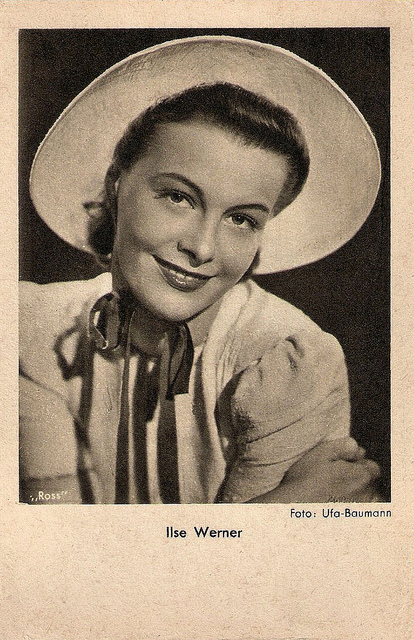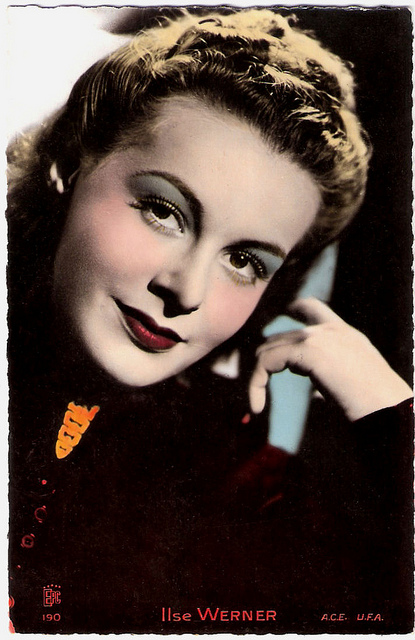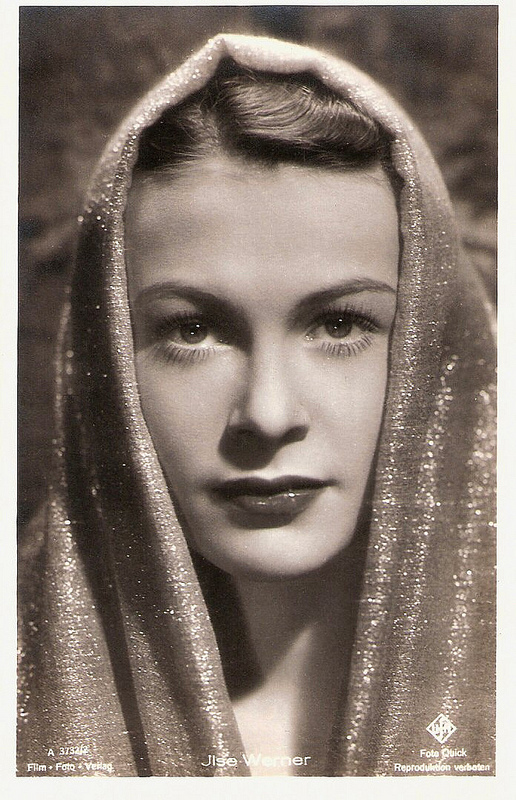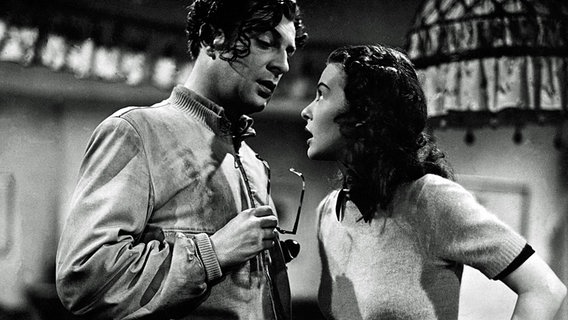World's First Television Star: Ilse Werner
 |
| Ilse Werner. |
If you haven't heard of Ilse Werner, that's perfectly normal: unless you're German or a big fan of German pop culture, there's no reason that you should. Werner is virtually unknown outside Germany. In brief, Ilse Werner was a stunning multi-talented entertainment star who excelled at just about everything that she tried. She reached her peak during the Third Reich years. To fully understand the reality of Germany during the war and after, Ilse Werner and her career are worth knowing about.
But, first things first: let's find out who Ilse Werner was; we'll get to your possible connection to her toward the end.
Ilse Werner's Beginnings
Ilse Werner was born Ilse Charlotte Still to O.E.G. Still, a Dutch trader/plantation owner, and German mother Lilly Werner on 11 July 1921, in Batavia, Dutch East Indies. She lived there until 1931, when her family moved to Germany. Ilse attended school in Frankfurt, then a few years later moved again to Vienna. She evidently had developed an interest in acting by this time, for instead of enrolling again in an ordinary curriculum she joined the Max Reinhardt Seminar (which still operates, incidentally). Reinhardt at this time was one of the world's most prominent directors (his 1935 "A Midsummer Night's Dream" starred James Cagney, Mickey Rooney and Olivia de Havilland). The school itself held classes at the Schönbrunner Schlosstheater, the imperial theatre in the Schönbrunn Palace. Obviously, it was a high honor for Ilse just to gain admittance. |
| German postcard by Ross, 1941-1944. Photo: Ufa / Baumann. |
Ilse Werner, German Superstar
Just to be clear, Ilse was not a Party member herself, just a performer in the Third Reich. That may not seem like much of a distinction, but it made a big difference after the war. There was a problem with her working in Germany: Ilse was Dutch due to her father's nationality (she did not become German until 1955). To be gainfully employed in the Reich, you needed to be German. However, Ilse projected the right image (a cheerful woman who can overcome anything), so the Propaganda Ministry granted Ilse a special work permit (they could be very lenient toward actors for some reason). Ilse made a smooth transition to the German film industry, signing with Universal-Films AG (Ufa) and moving to Berlin, where Ufa had its studio.Ufa knew a star when they found one, and they had a star in Ilse Werner. In her first few films, she played a supporting role, but by 1939 she was the headliner. Her breakthrough came the following year, she starred in "Wunschkonzert," a tale surrounding a real German radio show in which Wehrmacht soldiers made song requests. Ilse played the center of a love triangle between two Luftwaffe flyers (naturally flying together in the same bomber) vying for her affections, with everybody putting duty above love and cheering the "beautiful future" in a very disciplined Germanic fashion. Modern viewers may view the film as a turgid swill drained from the bottom of the Ministry of Propaganda, but contemporary German audiences loved it: the film became Ufa's highest-grossing film. The film also propelled the radio program to the top of the ratings in an early example of entertainment synergy.
 |
| Ilse Werner whistling in "We Make Music" (1942). |
Ufa remained independent under the Germans, but the war was the dominant topic of the day. Many (but not all) of its films unavoidably had wartime settings. One of Ilse's next films was obvious propaganda bait, "U-boat Westward!"; it actually has some merit as a drama, but there is no escaping that title. Ilse kept moving forward: she followed with another big success, "Wir Machen Musik" (We Make Music) (1942), a musical which was good enough to get a US company to release it a decade later.
 |
| French postcard by EPC, no. 190. Photo: ACE / Ufa. |
 |
| German postcard of Ilse Werner by Film-Foto-Verlag, no. A 3732/2, 1941-1944. Photo: Quick / Ufa. |
Ilse Werner During the Post-war Years
Having contrived by hook or by crook to be captured by the Americans (which must have taken some effort) and not the dreaded Soviets, Ilse hooked up with American journalist John de Forest - in that chaotic time, virtually any American was a catch for a refugee German girl - and eventually married him in 1948. They moved to Los Angeles, California, where Reinhardt also had fled, but he had passed away during the war. Temporarily banned from German films due to her films about U-boats and such (though she was never a Party member per se), and unknown in the US market, Ilse was at loose ends. She began to dub American films for the foreign market. Ilse became the German "voice" for Maureen O'Hara, for instance. Germans, of course, knew who was actually speaking, but to most Americans, she was just another émigré voice actress. During this time, Ilse's singing - and whistling - became a major outlet.After divorcing de Forest in 1953, Ilse released a string of moderately successful albums. She also did some successful stage work, but her films in West Germany were forgettable and could not compete with polished productions from Hollywood. By the mid-fifties, Ilse was appearing on television - again - as her film career dwindled, and during that era, television was seen as the graveyard for actresses. Ilse's declining film career probably had mostly to do with her advancing years and her passing from ingenue roles to more mature parts, with which she fewer credentials and perhaps fewer skills. However, her celebrity during the Third Reich years probably didn't help. Ilse's biggest post-war hit wasn't a film, but rather the single "Baciare" (Kiss, in Italian), which sold well in Europe during 1960.
 |
| Ilse Werner - Funk und Film Magazine Cover [West Germany] (5 October 1951). |
 |
| "Wir machen Musik" (1942) (photo: kpa). |
 |
| Ilse Werner continued releasing albums of new material into the 1970s and beyond. |
Wind of Change
Ilse continued performing, mainly in musical performances as herself, right up until her death from pneumonia at a Lübeck retirement home on 8 August 2005. Along the way, though, there was one curious incident that has passed into legend. A West German rock group, the Scorpions, had composed a song which began and ended with whistling segments. Lead singer and composer Klaus Meine was a brilliant rock musician - but whistling was not his thing. As legend has it, the Dutch Wisseloord Studios where they recorded tried everything to find a replacement for the whistling parts - but piano, guitar, and many other instruments simply didn't match the whistling vibe. The band itself and everybody associated with it roundly denies it (they claim that the producers assembled the whistling parts from bits and pieces of Meine's numerous awkward attempts, which sounds quite difficult), but the persistent rumor is that the studio secretly got Ilse Werner herself to record the critical whistling segments. Who better?Even if she didn't actually do the whistling (wait, let me say it for you cynics: "total myth"), whoever did the deed followed in the best traditions of German music - as established by the whistling Fräulein herself, Ilse Werner. Anyone in Germany with ears and a sense of history would recognize the covert allusion to World War II and Ilse's whistling, which also would soar over the head of outsiders. This, whether intentional or not, fit perfectly with the song's underlying theme of moving on from the past. With the whistling parts covered competently one way or another, Scorpions' 1990 "Wind of Change" became the most successful single by a German artist - in history.
Conclusion
Articles like this one about Ilse Werner don't involve great battles and bombing, so if that is how you think about war, apologies for not giving you what you sought. However, individual stories bring a sense of what was going on behind the lines, whether in Germany or elsewhere. They show how the war affected people both during it and long after. While many Americans may never have heard about Ilse Werner, it is a safe bet that most Germans would recognize the name instantly. Put simply, Ilse Werner was a talented performer whose work still enchants regardless of the politics surrounding her. Werner's is a tale that weaves together many unique strands behind the German war effort and shows how talent endures no matter its origination.Below, Ilse at her adorable best.
Another video of Ilse during her peak.
Ilse Werner doing Ja, das ist meine Melodie (1941).
Ilse's big 1942 hit, Wir Machen Musik.
2019





No comments:
Post a Comment